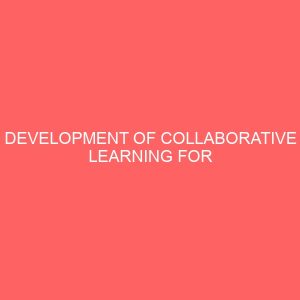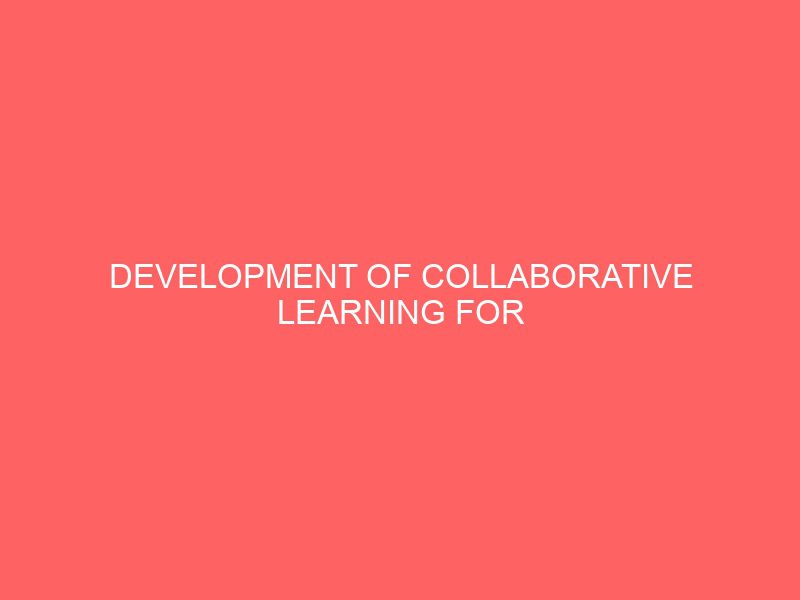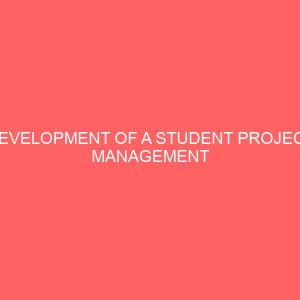Description
CHAPTER ONE
INTRODUCTION
Collaborative learning is gradually becoming popular as a method of knowledge delivery through the use of Internet and network technologies. In the field of tertiary education, collaborative learning has been seen as an alternative strategy to help educators to accommodate the numbers and the diversity of students who are coming into tertiary classrooms in Nigeria and the world in general. One of the advantages of collaborative learning that has been the focus of much research is the flexibility to meet the needs of the learner, through adaptability to different learner needs, learning patterns and settings, and media combinations that could benefit full-time campus based students as well as distance learners (Collis, 2001). The flexibility of collaborative learning has encouraged many educators to make their learning materials and resources available collaborative so that students can reach them through Internet at anytime and anywhere. Thus, provides many more opportunities for dialogue compared to print or broadcast-based distance education.
In the last few years, mobile devices have grown in popularity and their technologies have become pervasive, ubiquitous and networked with enhanced capabilities for rich social interactions. Also, many different types of technologies have been adding to the popularity of the mobile devices changing the educational landscape and programs of colleges and universities. Mobile learning is a new research area. The several attractive mobile learning tools have been designing and developing by integrating with the emerging technologies.
With the importance of collaborative learning as a pedagogical method in personal learning and collaborative experience, the learning application has been implanted
from elementary schools to universities. Mobile technology has been adapted as a main communication since it is well suited in engaging collaborative learning environments. The concept of mobile collaborative learning (MCL) is completely different from classroom based learning. This type of pedagogical learning method provides many possibilities, such as providing opportunities to groups of people working in same or different organizations to accomplish a specific goal using mobile devices.
1.2 BACKGROUND OF STUDY
In the 1960s and 1970s, educational computing took place primarily in large universities, using mainframe computers, and was mainly restricted to reading and typing text. The development of the microcomputer in the late 1970s led to a rapid spread of computing in schools, businesses and homes. Interaction with computers became possible via text, graphics, and voice and pointing. The release of personal computers (PCs) in the early 1980s resulted in wide expansion of computer use in both business and industry. The development in computer networks, from LANs to WANs, and to the Internet, permitted the sharing of information and resources. In the early 1990s, the creation of part of the Internet known as the World Wide Web (WWW) or the Web, transformed the entire computing landscape. The web has transformed from a network used by academia and government for exchange of textual material, into a worldwide multimedia resource. It is used by millions of people worldwide for activities such as learning, shopping, researching, and the exchange of textual, audio and graphic information (Samuel, 2006). Now a day the use of computers for learning and education is expanding rapidly, largely because of the popularity of the Internet and the WWW (Alessi, 1991). As many analysts and researchers say that the initial focus of much e-learning has been on asynchronous course delivery, are now predicting a rapid expansion of new synchronous models that enable the delivery of instruction to a group of distributed learners in real time, using a variety of interactive media; in effect a “virtual classroom”(Geoff, 2001).
Major research challenges are raised in developing MCL for educational object such as sharing knowledge, requesting for modified contents, fully accessing to enterprise data warehouse (EDW), delivering large rich multimedia contents, selecting technological components in designing appropriate architecture and adapting application protocols. In this paper, I proposed a conceptual prototype including a communication protocol to deliver rich multimedia contents, improve knowledge sharing process, provide easy to access and contain useful content modification facilities. Another contribution in the paper is to indicate usability issues which are necessary considered to design the application to obtain succinct information and fast feedback through the MCL.
The mobile learning system should include greater access to necessary content and information timely, reduced cognitive load during learning tasks and increased interaction with users and other systems. Also, the learning application plays as a default media player supporting audio and video files, and opens the lecture materials without discontinuity. Basically, in the mobile learning environment, the following running options must be included:
- Lecture Video
- Lecture Note
- Audio
- Quiz and Test
- Assignment
- Discussion
- Grade
To shape a culturally sensitive learning experience, mobile devices will require multimedia oriented network environments. Thus, it is important for designing and developing the wireless based middleware architecture supporting mobile learning system requirements.
Therefore, the demand of collaborative learning over the mobile device has been increasing as a major education element.
1.3 Statement of the Problem
Learning should not be limited to classroom activities or in an organized setting like a classroom, but rather should be seen as what can actually occur collaborative using our smartphones through mobile applications connected to the internet. Depending on classroom lectures is not enough, student’s need an environment that can be very convenient for them to share ideas and improve on what they know through sharing digital contents.
1.4 Aim and Objectives of the Study
This Research aims at providing a medium through which Educational learning can occur, between a group of persons. The specific objectives are as follows:
- To develop a mobile friendly application that can be used for collaborative learning between students.
- To provide a safe application, that can store users information’s and share resources.
- To provide an collaborative platform that can complement classroom learning, which can increase understanding.
1.5 Scope of the study
This research titled “Development of Mobile Networking Application for Collaborative Learning” attempts to provide a mobile application for students in groups to discuss, share documents and test their understanding. Furthermore, this Research is limited to Educational learning between persons in specific groups, which will be coordinated by group administrators.
1.6 Limitation of the Study
Limitations to this research were basically Time and access to educational resources from past research conducted in relation to this study.
1.7 Significance of the study
- To provide a learning platform for students and teachers to exchange materials.
- To provide a platform for students to share ideas and learn in groups
- To help teachers get real time assessment of the learning process going on between their students.
- To provide a digital platform for learning to limit using the internet for less important activities.
1.8 Definition of Terms
Collaborative learning: is a situation in which two or more people learn or attempt to learn something together.
Social Media: are computer-mediated technologies that facilitate the creation and sharing of information, ideas, career interests and other forms of expression via virtual communities and networks.
Networking: Networking is a process that fosters the exchange of information and ideas among individuals or groups that share a common interest.
Mobile Applications: A mobile app is a computer program designed to run on a mobile device such as a phone/tablet or watch.
Smartphone: A smartphone is a handheld personal computer with a mobile operating system and an integrated mobile broadband cellular network connection for voice, SMS, and Internet data communication; most if not all smartphones also support Wi-Fi.
Internet: is the global system of interconnected computer networks that use the Internet protocol suite (TCP/IP) to link devices worldwide.








Reviews
There are no reviews yet.